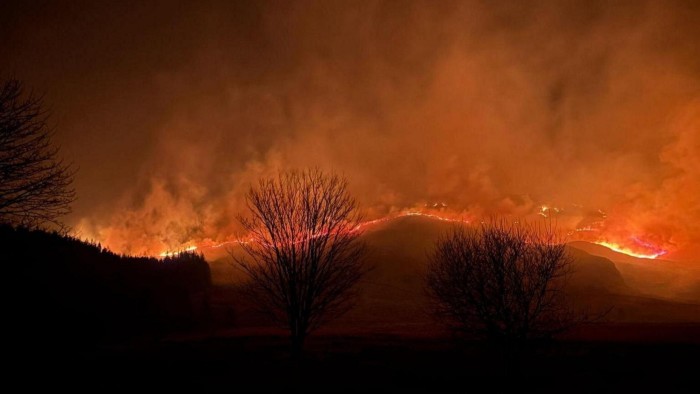Unlock the Editor’s Digest for free
Roula Khalaf, Editor of the FT, selects her favourite stories in this weekly newsletter.
The number of wildfires in the UK has soared above the historic average as firefighters battle blazes across Scotland and Northern Ireland.
A fire in Galloway, so intense it could be seen from space, started on Thursday before spreading into East Ayrshire, has been brought under control by 100 firefighters and water-bombing helicopters.
Fire engines were still attending a separate outbreak on Monday north of Ullapool in the Highlands.
In Northern Ireland, the authorities have dealt with more than 140 wildfires since Thursday, with a major incident declared over the weekend because of a large blaze in the Mourne Mountains.
In the year to date, the cumulative weekly number of fires in the UK has risen to 48, compared with the long-term average of 15 over the period 2006-2024, but below the historic high of 136, according to the European Forest Fire Information System (Effis).
The Copernicus Effis programme records forest fires based on satellite observations going back to 2006. It does not distinguish between wild land and managed fires.
The UK’s National Fire Chiefs Council, warning that climate change is driving extreme weather events such as wildfire activity, has reported 286 incidents in England and Wales in the year to date
There were 100 more fires than in 2022, when high temperatures triggered “unprecedented wildfire activity”, and in 2023, which was wetter.
“The climate is changing, making the risk of wildfires greater,” said Katrina Candy, director of The Heather Trust, a moorland charity. “So, we need sensible planning.”
In Scotland, firefighters deal with an average of around 170 wildfires a year, according to the Scottish Fire and Rescue Service, with 80 per cent of historic incidents occurring between March and May.
The SFRS on Monday said it expected to issue another wildfire warning this week, urging people to be wary when extinguishing cigarettes or cooking outdoors.
The combination of hotter, drier summers and wetter, warmer winters associated with climate change is increasing the risk of wildfires, say climate scientists.
The UK has been unseasonably dry in recent months with rising temperatures leaving land in some areas parched.
Michael Bruce, managing director of Firebreak Services, said longer-term weather forecasts suggested a more extended spring fire season than usual.
Prevailing weather conditions, with frosty nights followed by sunny days, provided a particular hazard, he added. “These are the most drying conditions, thereby increasing the chances of an ignition force connecting with available fuel,” he said.
Ed Hawkins of the National Centre for Atmospheric Science at the University of Reading said the risk of wildfires, while low, was increasing with climate change.
“When we get dry spells like the past few weeks, the conditions are also hotter, which raises the risk of wildfires,” he said. “We will all need to learn to be more careful to avoid accidental ignition of fires in hot and dry conditions.”

Some experts identify changing land use patterns as another factor driving wildfires, especially in Scotland, where increasing tracts of land are being rewilded for aesthetic purposes or to grow trees and restore peatland commercially for carbon credits.
Controlled burning of moorland vegetation, known in Scotland as muirburn, has been historically used to foster grouse breeding for sport and also manages wildfire risk, its proponents say. Around 96 per cent of fires occur outside of managed moorland, according to the James Hutton Institute.
But Max Wiszniewski of the REVIVE coalition, which campaigns for the reform of grouse moors, said muirburn brings a risk of fires getting out of control, arguing that strategically rewetting the land would be a better longer-term solution for tackling wildfires.
“When there is an increase in vegetation that is not managed in a traditional way, there is a risk,” said Candy.
Rural landowners should work with neighbours to establish wildfire management plans, including buffer zones, firebreaks and emergency access plans, she said.
“We will see more and more of this as climate changes, so it is essential to have a plan to deal with the heightened risk,” she added.

